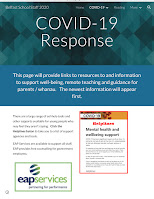Today marks the 10th anniversary of the 7.1 earthquake that began an unprecedented change in Christchurch impacting on any every aspect of our lives, including significant change for those of us in education. You would expect that after 10 years, this anniversary event would not evoke such strong emotions of loss, change, and an even greater realisation that our lives are different. We have a city centre that has been rebuilt in many places, new subdivisions, many new school buildings and relocations, and new houses. Around every corner though there are still broken buildings, homes, streets and endless road cones. We have come a long way, and yet there is still a long way to go.
As educators, we returned to our schools early and re-established the routines for our students and communities. We parked our personal situations each day to focus on our children and tried to maintain some semblance of order while the earth continued to shake and disrupt us. We weren't described as essential workers; that terminology has only recently emerged, however that was the role we played. Many schools became the life line for their communities and pastoral care expanded well beyond just the children attending school each day. It was an exhausting, emotionally challenging time of uncertainty, followed by even greater disruption a few months later when the smaller, but more devastating quake struck in February taking the lives of so many.
Our communities came together to support each other, there were many acts of kindness and we used dark humour to boost our morale. The YKYFCW ( You know you're from Christchurch when ...) memes made us laugh. We found a new word to describe our broken city, buildings and lives - "MUNTED". It was a great word with no other explanation required if you lived here. We grew really tired though of being called "resilient". We didn't want to be resilient when the changes posed more and more challenges. We just wanted normal. For those of us in communities where schools were relocated for years, merged or closed, we picked up the challenges and started forming new school cultures and environments, taking in our stride the grief of the community associated with the loss. We separated ourselves from the political battles that went with school closures and focused positively on the opportunities for rebuilding our schools. We kept going somehow.
 |
|

Our fight and flight mechanisms have remained on a much higher alert level since 2010. We see it in our children, our parents and communities, and we deal with the constant fallout of anxiety that brings aggression into our classrooms and playgrounds. Our pastoral systems are clogged with children and adults needing support for mental health. Today highlights all that we have been through and the hope that we had, that there would be some normality at some point, has been stretched to the limit with the terrorist event of 2019 and now the pandemic. Perhaps that's why today seems so hard.
In today's DFI Dorothy talked about the emergence of Manaikalani 10 years ago and the amazing development of this initiative that has become so effective in addressing equity issues and accelerating student achievement. For those of us working in schools dramatically impacted by the quakes, the partnership with Manaiakalani has become so significant. Our students have wonderful opportunities to grow and connect, to participate in new and engaging environments that support them to overcome the disadvantages they have been living with for most, if not all of their lives, The professional learning for our teachers, so generously funded by Manaiakalani, is transformative and so gratefully received. I wonder if any of us had thought 10 years ago about where both of these journeys would take us. That they have both converged is a blessing.
Nga mihi nui Manaiakalani.




